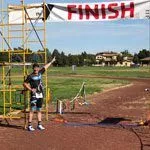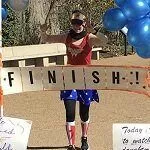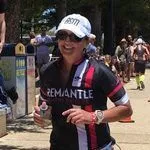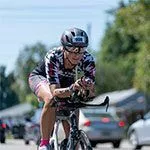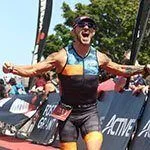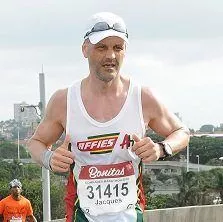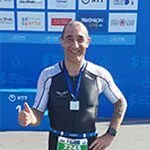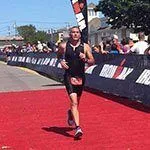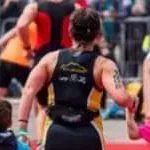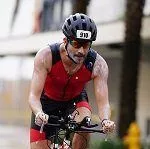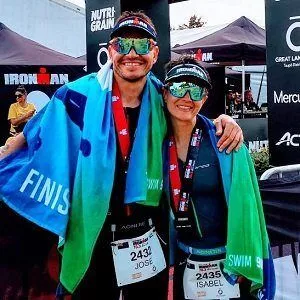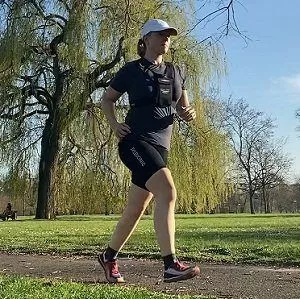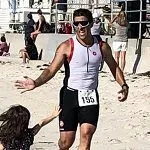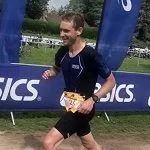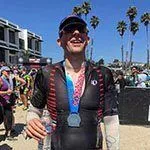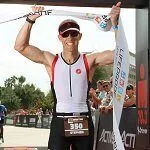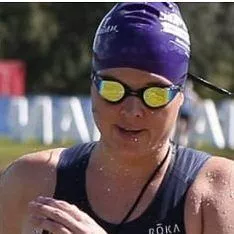Intensity Guidelines for 80/20 Triathlon
by Matt Fitzgerald and David Warden
We recommend also reading Understanding Your 80/20 Triathlon Plan and Understanding Your TrainingPeaks.com Structured Workout Plan.
Your 80/20 Triathlon plan employs a seven-zone intensity scale. Performing each workout and workout segment at the right intensity is at the heart of 80/20 training. This article provides all of the information you’ll need to determine your intensity zones so you can monitor your intensity during workouts and ensure you’re always in the right zone.
Your personal intensity zones can be automatically calculated based on the protocols described below at the 80/20 Zone Calculator or directly in TrainingPeaks.com using the steps outlined in the document Understanding Your TrainingPeaks.com Structured Workout Plan. Beginner athletes may find these tests difficult, so feel free to use perceived effort (explained in the second-to-last section) until you are comfortable doing the testing below.
There are four ways to measure intensity: pace, heart rate, power, and perceived effort. The testing protocols for all four types are listed below. Each metric has different applications among the three triathlon disciplines. Each metric also has certain advantages and disadvantages. Power is an output, pace is an outcome, and heart rate is an indicator. Let's use an automobile as an example. Horsepower (power) is the output, and represents actual work performed regardless of terrain, grade, or environmental factors. Your speedometer (pace) indicates the speed, or outcome. Your engine temperature (heart rate) represents how the car is responding to the output and environment. During a hilly ascent, the output (power) might be high, but the outcome (speed) might be low. On a hot day, the engine temperature (heart rate) might be very high even when stopped at a light with almost no output and zero outcome. For this reason, power is considered superior to pace, and pace superior to heart rate to measure intensity. There are some exceptions, such as hills, where HR can be superior to Pace to measure intensity. The recommended best-practice is to use Power or Pace as your primary measure, with HR as a secondary measure.
Pace is useful in swimming and running because it’s a performance-relevant variable and an outcome. You race on the clock, so why not also train by the clock? However, pace becomes unreliable when you’re running uphill or downhill and is not recommended for cycling.
Heart rate is useful in cycling and running because it helps triathletes avoid the single most common training mistake: pushing too hard in workouts that are supposed to be done at low intensity (Zones 1 and 2). But heart rate is not a reliable way to monitor intensity during short efforts at high intensity because heart rate lags behind abrupt changes in pace. HR for a given effort is also easily influenced by environmental factors, such as temperature, and is impractical to measure in real time when swimming. HR is only an indicator of how your body is responding to training, it is not an output or outcome.
Power, the output, is the newest way to measure running intensity and has become the gold-standard intensity metric for cycling and running. Power monitoring provides instant feedback on workout output and its reliability is not compromised by terrain or temperature. Cycling and running power meters are more expensive than GPS and HR monitors, however, and power monitoring during swimming is not yet possible except with some land-based training systems, such as the Vasa Ergometer.
Rate of Perceived Effort— RPE, or your subjective sense of how hard you are running—is important because it ultimately determines how fast you run in races. You may set and pursue time-based goals, but perceived effort has the final say in deciding whether you actually do maintain your goal pace or run faster or slower.
However, perceived effort is poorly calibrated in many triathletes and relying on it exclusively carries some risk. In particular, most end up running at Zone X (in the gap between Zones 2 and 3) whenever they intend to train at low intensity if they go by feel. Whenever possible, use one of the more objective measures of intensity—pace, heart rate or power—as your primary intensity metric. In some scenarios, RPE is the only reliable method to measure intensity. For example, when running short intervals up hills, Pace zones are invalid and the interval may be too short for Heart Rate to "catch up." Without a running Power meter, RPE can replace Pace and Heart Rate in hills.
The table below ranks the reliability of the four intensity metrics as they apply to each triathlon discipline.
| Rank | Swim | Bike | Run |
|---|---|---|---|
| 1 | Pace | Power | Power |
| 2 | Power | Heart Rate | Pace |
| 3 | RPE | RPE | Heart Rate |
| 4 | Heart Rate | X | RPE |
Establishing personal intensity zones
Once you have chosen a method of monitoring intensity in your 80/20 training plan (and you may use more than one), you need establish personal intensity zones for that specific metric, which is done through lactate threshold testing.
Lactate Threshold
80/20 triathlon plans use lactate threshold testing to determine training zones. Lactate threshold is defined as the exercise intensity at which lactate, an intermediate product of glucose metabolism, begins to accumulate in the blood. In practical terms, it’s the highest exercise intensity that can be sustained for up to 60 minutes. The most reliable field tests for use in identifying appropriate individual training intensities are those that pinpoint the lactate threshold (LT). Although monitoring the blood lactate concentration during exercise isn't practical or easy, this isn’t a problem. The lactate threshold field tests detailed below are designed to reveal your pace, power, or heart rate at LT intensity, allowing you to use these more practical intensity metrics to regulate your effort in workouts.
LT represents the top end of Zone 3 in the 80/20 intensity scale and is the polestar for determining all other zones. Once you determine your LT, you can enter it at the 80/20 Calculator or your Zone settings in TrainingPeaks.com to determine your custom 80/20 Zones.
Swim Pace
Pace is the most useful intensity metric for swimming. Your seven custom swim pace training zones are based on your swim pace at lactate threshold intensity. The best way to find your lactate threshold pace in the water is with something called the critical velocity test. It’s fairly simple: Go to the pool, warm up with some easy swimming, and then swim 400 meters or yards as fast as you can, recording your time. Rest for two minutes several minutes and then swim 200 meters or yards as fast as you can, again recording your time. Your plan has regular swim workouts scheduled every 3-4 weeks to test your critical velocity in order to re-establish your zones. Note that your zones will be specific to meters or yards, and if you train in a pool measured differently than the one you tested in, you will have to adjust that session (your pace zones for 100 yards will be approximately 10 percent faster than your pace zones for 100 meters).
After your test, use the zone calculator or use the 80/20 auto-calculation directly in your TrainingPeaks Zone settings to determine your swim zones. Alternatively, you can calculate your threshold swim pace based on the following formula:
Critical velocity (CV) = (400 meters/yards – 200 meters/yards) ÷ (400 time – 200 time)
Let’s look at an example. Suppose you swim your 400-yard test in 4:21 (4.35 minutes) and your 200-yard test in 2:02 (2.04 minutes). Your critical velocity, then, is (400y – 200y) ÷ (4.35 min. – 2.04 min.) = 86.6 yards/min. However, it is customary to express critical speed in the form of time per 100 yards. To make this conversion, divide 100 by your critical velocity. In this example, 100 ÷ 86.6 = 1.15. So your lactate threshold pace per 100 yards is 1.15 minutes, or 1 minute and 9 seconds.
A mathematician will notice that the CV formula result is influenced both by the time and the delta between the two tests. Even if your total combined 400+200 time goes down from test A to test B, if the difference between the 400 and 200 times are greater in test B, your CV might actually increase. In this way, the CV test "punishes" the athlete for poor pacing.
Some swimmers therefore may have a difficult time with the CV test. An alternative test is the 1,000 yard time trial. Swim 1000 yards (or meters) as fast as you can. Your average pace per 100 is your lactate threshold swim pace.
Run Pace
The most reliable way to determine your pace threshold is to enter a recent race result for the 5K, 10K, half marathon, or marathon distance into the 80/20 Zone Calculator. The performance does not have to be from an official race—a virtual or solo race will do—but it should reflect your current maximum capability for a given distance, whether it comes from competition or training or is simply an estimate of how fast you could run a given distance today.
Alternatively, you can perform a 20-minute time trial (covering as much distance as possible in 20 minutes) to determine your Threshold Pace (TP) and enter this number into the appropriate field of the pace calculator. Begin with a warm-up that consists of 15 minutes of easy jogging that ends with a few 15-second surges at the pace you intend to run for the time trial. Next, run as far as you can in 20 minutes, being careful to avoid starting at a pace that’s too fast to sustain and thus slowing down involuntarily near the end.
If you already know your lactate threshold heart rate (LTHR), you can use it to find your TP with an even shorter field test. After warming up, play with your pace until your heart rate settles in at your previously established LTHR for 10 minutes. Your pace at this heart rate is close to your TP.
Run Heart Rate
The simplest way to determine your heart rate threshold is to back into them through pace. First, follow the guidelines under the Pacing Testing section of this article to establish your Threshold Pace (TP).
The next step is to determine your Lactate Threshold Heart Rate (LTHR) from your TP. To do this, warm up with 10 minutes of easy jogging and then accelerate to your TP on a smooth, flat path or road. Wait for your heart rate to stop increasing and plateau. The number you see after it levels off is your LTHR. Now go to the Run and Cycling Heart Rate section of the endurance calculator and enter your lactate Threshold Heart Rate. Your seven heart rate training zones will be calculated automatically.
If you have not yet established your TP, you can find your LTHR independently through a time trial. Begin with a warm-up that consists of 15 minutes of easy jogging with a few 15-second surges at the pace you intend to run for the time trial. Next, increase your effort to the highest level you feel you can sustain for 20 minutes and hit the lap button on your heart rate monitor watch. Five minutes into the test, hit your lap button again. Fifteen minutes later, at the end of the 20-minute time-trial, hit the lap button again or end the time trial. Your LTHR is your peak 15-minute average within that 20-minutes test (the average heart rate in beats per minute (BPM) of the final 15 minutes of the 20-minute test).
Note that Lactate Threshold Heart Rate is slightly different in running than it is in other aerobic activities, so if you choose to cross-train, you’ll need to do separate tests in each activity.
Also note that heart rate is significantly influenced by factors such as temperature, humidity, sleep, stress, time of day, and even when you last ate. Therefore, your Lactate Threshold Heart Rate test result is specific to the environment and conditions in which you test. For example, an LTHR test indoors in February in the morning will not be the same as an LTHR test in July outdoors in the afternoon. Perform your LTHR in the environment that most accurately represents where you will do the bulk of your training.
For various reasons, most athletes find that their threshold is 5-10 bpm lower indoors than outdoors. For this reason, it may be practical to maintain separate indoor and outdoor HR zones. Or simply adjust your zones appropriately when moving between outdoor and indoor environments.
Cycling Heart Rate
The processes for finding your cycling LTHR are nearly identical to the running protocols. The most commonly used method is the time trial test. Warmup for 15 minutes. Next, increase your effort to the highest level you feel you can sustain for 20 minutes and hit the lap button on your heart rate monitor watch. Five minutes into the test, hit your lap button again. Fifteen minutes later, at the end of the 20-minute time-trial, hit the lap button again or end the time trial. Your LTHR is your peak 15-minute average within that 20-minutes test (the average heart rate in beats per minute (BPM) of the final 15 minutes of the 20-minute test).
You can find your cycling heart rate training zones through power also. First, follow the guidelines under the Cycling Power section of this article and use the 80/20 Zone Calculator or Zone settings in TrainingPeaks to establish your cycling power zones and FTP.
The next step is to determine your running cycling LTHR from FTP. To do this, warm up with 10 minutes of easy cycling and then accelerate to your FTP on a smooth, flat road. Wait for your heart rate to stop increasing and plateau. The number you see after it levels off is your cycling LTHR. Now go to the Running and Cycling Heart Rate section of the Zone Calculator or Zone settings in TrainingPeaks and enter your lactate threshold heart rate. Your seven heart rate training zones will be calculated automatically.
The same environmental factors that influence HR described in the Run Heart Rate section above apply to Cycling Heart Rate as well.
Run Power
The most straightforward field test to find threshold power is a 20-minute time trial. Begin with a warm-up that consists of 15 minutes of easy jogging with a few 15-second surges at the pace you intend to run for the time trial. Next, run as far as you can in 20 minutes, being careful to avoid starting at a pace that’s too fast to sustain and thus slowing down involuntarily near the end. Your running threshold power, or rFTP, is equal to 95 percent of your average power over the full 20-minute time trial, which can be entered into the Run Power section of the Zone Calculator.
The leading brand of run power meter, Stryd, offers a different way to establish power zones. Stryd power meters automatically estimate a variable called critical power (CP) for individual runners through their use in the normal training process. For 80/20 structured workouts to sync to appear in the Stryd platform and apps with the same power targets that you find in TrainingPeaks it is recommended that you disable Stryd’s Auto-Calculated Critical Power and manually set the Stryd CP to match your rFTP as it is defined above. For full details on setting up seamless integration of 80/20 and Stryd, see this article from Stryd.
If you already know your lactate threshold heart rate (LTHR), you can use it to find your rFTP with a short field test. After warming up, play with your power until your heart rate settles in at your previously established LTHR for 10 minutes. Your power at this heart rate is close to your rFTP.
Cycling Power
As you might expect, the processes for establishing cycling power zones is similar to the those used to determine run power zones. The time-trial method starts with a 15-minute warm-up that combines easy pedaling with a few 10-second bursts at the effort level you anticipate sustaining through the upcoming time-trial. When your warm-up is complete, ride as far as you can in 20 minutes, taking care to avoid starting too fast and losing power before you finish. 95% of your average power for that 20 minutes is your cycling functional threshold power, or FTP. Enter the results into the Cycling Power section of the 80/20 Zone Calculator or Zone settings in TrainingPeaks to determine your zones.
If you already know your cycling lactate threshold heart rate (LTHR), you can use it to find your FTP with an even shorter field test. After warming up, increase your intensity until your heart rate settles in at your previously established cycling LTHR for 10 minutes. Your power at this heart rate is close to your FTP. This method is useful when your training plans calls for a CT workout during a rest week, as the CT workouts are long, uninterrupted efforts in upper Zone 3.
Note that with the full 20-minute protocol, the need to perform separate tests for LTHR and FTP is dispensed with entirely if you have a device that captures both heart rate and power, as this enables you to establish LTHR and FTP in the same field test.
Indoor and Outdoor Threshold Testing
For various reasons, most athletes will find that their thresholds will be 5-10 bpm and 10-15 watts lower indoors than outdoors. For this reason, it may be practical to maintain both a separate indoor and outdoor set of zones. Or, simply adjust your zones accordingly when moving between outdoor and indoor environments.
Aero and Upright Position Threshold Testing
Similar to the heart rate and power delta introduced by indoor and outdoor exercise, wattage can significantly change for a given heart rate when switching between the aero and upright cycling positions. This is normal, and the benefit gained from improved aerodynamics is well worth the decrease in power:hr ratio. While the delta between upright and aero can decrease with experience over time, it will never reach parity. For this reason, it may be best to establish two sets of zones: one for upright and one for aero position. A separate test is possible, but not necessary as you can generally quantify the precise wattage difference between the two positions. Because you will most likely race in an aero position, your time spent in aero and using the aero position zones should progressively increase as you approach race day.
Talk Test
While it might not seem terribly scientific, the Talk Test is scientifically proven to be an accurate way to assess run fitness and determine appropriate training intensity zones. Because it is less challenging than other field tests, we recommend the Talk Test as a way to adjust your pace, heart rate, or power zones as you make your way through the training process. Whenever you feel your fitness has changed enough to justify a zone adjustment, and you’re not in the mood for a time trial, simply incorporate a Talk Test into any Foundation Run already on your schedule.
The Talk Test may be done either outdoors or on a treadmill. We recommend that you do it where you train most often. Be aware that most treadmills are poorly calibrated for pace, so if you use a treadmill for the purpose of determining pace zones, the result might not be valid outdoors. If you do the test outdoors, choose a smooth, flat route if possible.
- Start jogging at a very slow pace—substantially slower than your normal jogging pace.
- After 1.5 minutes, hit the lap button on your device, note your heart rate, pace, and/or power, and recite a statement that is approximately 50 syllables in length while continuing to jog at the same pace. The American Pledge of Allegiance is often used in the U.S., but any statement will do, and even simply counting will suffice. For example: “One hundred twenty-one, one hundred twenty-two, one hundred twenty-three, one hundred twenty-four, one hundred twenty-five, one hundred twenty-six, one hundred twenty-seven, one hundred twenty-eight.” After you finish speaking, judge whether you were able to do so comfortably. There are three options: yes, no, and not sure. Allow 30 seconds for this step, then hit your lap button again.
- If you were able to speak comfortably, pick up your pace slightly (aim for something in the range of 10 seconds per kilometer or 15 seconds per mile). The smaller you make your speed increases in this test, the more accurate the result will be. When another 1.5 minutes has passed, again note your heart rate, pace, and/or power and recite the same 50-syllable statement as before. As before, continue running at the same pace will performing this second test and allow 30 seconds for this step.
- If you were again able to speak comfortably, accelerate slightly once more, continuing to alternate 1.5-minute running segments and 30-second testing (while still running) segments until you are no longer able to speak comfortably or you’re not sure. At this point the test is complete, and you may either stop or finish out your Foundation Run. Note that it's highly likely you will reach a point where you're not sure if you're able to speak comfortably before you reach a point where you're sure you can't speak comfortably. This is not a problem and will not affect the validity of your result. Any degree of uncertainty about your comfort in speaking counts as "no" and ends the test.
- The key number that you want to take away from this test is the highest heart rate, pace, and/or power at which you were still able to speak comfortably. In other words, if you completed nine steps, and you were no longer able to speak comfortably in the ninth and last step, then the result of your test is the heart rate, pace, or power you noted at the end of the eighth step. Below is an example of what a complete test looks like. The numbers in boldface represent the results.
| Duration | Time from Start | Pace
(mm:ss/ |
Power
(watts) |
Heart Rate
(BPM) |
Speak Comfortably? | ||
|---|---|---|---|---|---|---|---|
| Run Segment 1 | 1:30 | 0:00 |
10:00 |
188 |
112 |
Yes |
|
| Test Segment 1* | 0:30 | 1:30 | |||||
| Run Segment 2 | 1:30 | 2:00 |
9:50 |
192 |
117 |
Yes |
|
| Test Segment 2 | 0:30 | 3:30 | |||||
| Run Segment 3 | 1:30 | 4:00 |
9:40 |
196 |
122 |
Yes |
|
| Test Segment 3 | 0:30 | 5:30 | |||||
| Run Segment 4 | 1:30 | 6:00 |
9:30 |
200 |
127 |
Yes |
|
| Test Segment 4 | 0:30 | 7:30 | |||||
| Run Segment 5 | 1:30 | 8:00 |
9:20 |
204 |
132 |
Yes |
|
| Test Segment 5 | 0:30 | 9:30 | |||||
| Run Segment 6 | 1:30 | 10:00 |
9:10 |
208 |
137 |
Yes |
|
| Test Segment 6 | 0:30 | 11:30 | |||||
| Run Segment 7 | 1:30 | 12:00 |
9:00 |
212 |
141 |
Yes |
|
| Test Segment 7 | 0:30 | 13:30 | |||||
| Run Segment 8 | 1:30 | 14:00 |
8:50 |
216 |
145 |
Yes |
|
| Test Segment 8 | 0:30 | 15:30 | |||||
| Run Segment 9 | 1:30 | 16:00 |
8:40 |
220 |
148 |
Not Sure |
|
| Test Segment 9 | 0:30 | 17:30 | |||||
*Be sure to continue running at the same pace during each test segment!
- Go to the online 80/20 Endurance Zone Calculator and enter your result in the appropriate Talk Test field.
Perceived Effort
While we don't recommend that you use perceived effort as your primary intensity metric in training, it does have its place. Because perceived effort responds quickly to changes in intensity, it is a useful tool for establishing the right intensity at the start of each workout segment, before you have a chance to capture a split time and before your heart rate has had a chance to adjust to the change of intensity.
Note, however, that perceived effort increases the longer you go at any intensity, so it is only useful for establishing initial intensity. For example, at the end of a very long run at a moderate pace, your perceived effort level may be “14” even though you are still in Zone 2.
Use the guidelines in the following table to regulate your workout intensity by perceived effort. Note that these guidelines work in running as well as in all types of cross-training activities.
| Rating | RPE Description | 80/20 Zone |
|---|---|---|
| 6 | No exertion | |
| 7 | Extremely light | Zone 1 |
| 8 | ||
| 9 | Very light | |
| 10 | Zone 2 | |
| 11 | Light | |
| 12 | ||
| 13 | Somewhat hard | Zone X |
| 14 | ||
| 15 | Hard | Zone 3 |
| 16 | ||
| 17 | Very hard | Zone Y and Zone 4 |
| 18 | Zone 4 | |
| 19 | Extremely hard | Zone 5 |
| 20 | Maximum exertion |
Threshold Testing
Because your fitness level and lactate threshold can change quickly, it’s important to keep your thresholds and zones current throughout the training process by retesting your lactate threshold every few weeks. Repeating your chosen field test in every recovery week (recovery weeks fall ever third or fourth week in our 80/20 Triathlon plans) is the theoretical ideal. As a practical matter, however, this is onerous for many athletes.
Fortunately, your 80/20 training plan includes Swim Time Trial (STT), Cycling Tempo (CT), and Running Tempo (RT) workouts that may serve as zone testing sessions. Most of these sessions feature Zone 3 effort that are less than 20 minutes in duration. Advanced athletes can replace these workouts with the 20-minute time trials described above. Another option is to use the “backing in” method of verifying running threshold pace or cycling or running threshold power. Because LTHR changes less than TP and rFTP over the course of a training plan, you can retest either of these variables in the context of CT and RT workouts featuring Zone 3 efforts as short as 10 minutes by adjusting your effort until your heart rate levels off at your previously determined LTHR and observing the pace or wattage that corresponds to it.
Alternatively, the Talk Test can be performed during any Foundation Run or Recovery Run whenever you feel that you have “outgrown” your current zones and act as a provisional threshold until more formal testing can be done.
Also note that if you are an intermediate- or advanced-level athlete and you use heart rate as your primary intensity metric, you probably don’t need to update your zones very often. This is because LTHR doesn’t change a lot with changes in fitness once you’re past the beginner (or starting-over) phase. What you will find as you gain fitness is that you run faster and faster at the same heart rates. Indeed, one simple way to update your pace or power zones is to do a test where you run at your current known LTHR and identify the corresponding pace/power, then plug this number into the appropriate calculator. For example, if you know that your LTHR is consistently stable at 160 BPM but you notice that you’re running faster at any given HR lately, do a run where you lock into a heart rate of 160 BPM and note the corresponding pace/power. Say your pace is 7:07/mile at this HR. This, then, is your approximate Threshold Pace. It’s best to do this particular test within the context of a scheduled run that targets Zone 3.
Note that CT and RT sessions occur less frequently in the L2 and L3 plans because 1) the high volume of these plans makes frequent high-intensity/high-duration testing risky, 2) we assume advanced athletes have a longer training history and are already confident in their lactate threshold, and 3) advanced athletes tend to experience smaller changes in lactate threshold than do beginner athletes. But if you ever feel you’re “outgrowing” your zones, feel free to insert one of the easier testing options into your next recovery week if it does not already contain a CT or RT session.












